Purpose: The purpose of this study is to assess the evolution of restaurant locations in the city of Hamilton over a 12-year period (1996 to 2008) using GIS techniques. Retail theories such as central place, spatial interaction and principle of minimum differentiation are applied to the restaurant setting. Design/methodology/approach: A database of restaurants was compiled using the NZ yellow pages and contained 981 entries that consisted mainly of location addresses and types of cuisine. This paper focuses on locational patterns only. Findings: A process of geo-coding and clustering enabled the identification of two clustering periods over 12 years for city restaurants, indicating locational patterns of agglomeration within a short walking distance of the CBD and spill over effects to the north of the city. Research limitations/implications: The data do not allow statistical analysis of the variables causing the clustering but offer a visual description of the evolution. Explanations are offered on the possible planning regimes, retail provision and population changes that may explain this evolution. Practical implications: The findings allow identification of land use patterns in Hamilton city and potential areas where new restaurants could be developed. Also, the usefulness of geo-coded data in identifying clustering effects is highlighted. Originality/value: Existing location studies relate mostly to site selection criteria in the retailing industry while few have considered the evolution of restaurant locations in a specific geographic area. This paper offers a case study of Hamilton city and highlights the usefulness of GIS techniques in understanding locational patterns.
LINK
Co-creation as a concept and process has been prominent in both marketing and design research over the past ten years. Referring respectively to the active collaboration of firms with their stakeholders in value creation, or to the participation of design users in the design research process, there has arguably been little common discourse between these academic disciplines. This article seeks to redress this deficiency by connecting marketing and design research together—and particularly the concepts of co-creation and co-design—to advance theory and broaden the scope of applied research into the topic. It does this by elaborating the notion of the pop-up store as temporary place of consumer/user engagement, to build common ground for theory and experimentation in terms of allowing marketers insight into what is meaningful to consumers and in terms of facilitating co-design. The article describes two case studies, which outline how this can occur and concludes by proposing principles and an agenda for future marketing/design pop-up research. This is the peer reviewed version of the following article: Overdiek A. & Warnaby G. (2020), "Co-creation and co-design in pop-up stores: the intersection of marketing and design research?", Creativity & Innovation Management, Vol. 29, Issue S1, pp. 63-74, which has been published in final form at https://doi.org/10.1111/caim.12373. This article may be used for non-commercial purposes in accordance with Wiley Terms and Conditions for Use of Self-Archived Versions. LinkedIn: https://nl.linkedin.com/in/overdiek12345
MULTIFILE

This study answers the questions on which factors drive the adoption of AI and MR in the multiplex retail environment and which factors drive consumers’ behavioral responses to the multiplex retail environment.
DOCUMENT
Purpose: This study, a conceptual paper, analyses the growth of curation in tourism and hospitality and the curator role in selecting and framing products and experiences. It considers the growth of expert, algorithmic, social and co-creative curation modes and their effects. Design/methodology/approach: Narrative and integrative reviews of literature on curation and tourism and hospitality are used to develop a typology of curation and identify different curation modes. Findings: Curational techniques are increasingly used to organise experience supply and distribution in mainstream fields, including media, retailing and fashion. In tourism and hospitality, curated tourism, curated hospitality brands and food offerings and place curation by destination marketing organisations are growing. Curation is undertaken by experts, algorithms and social groups and involves many of destination-related actors, producing a trend towards “hybrid curation” of places. Research limitations/implications: Research is needed on different forms of curation, their differential effects and the power roles of different curational modes. Practical implications: Curation is a widespread intermediary function in tourism and hospitality, supporting better consumer choice. New curators influence experience supply and the distribution of consumer attention, shaping markets and co-creative activities. Increased curatorial activity should stimulate aesthetic and stylistic innovation and provide the basis for storytelling and narrative in tourism and hospitality. Originality/value: This is the first study of curational strategies in tourism and hospitality, providing a definition and typology of curation, and linking micro and macro levels of analysis. It suggests the growth of choice-based logic alongside service-dominant logic in tourism and hospitality.
MULTIFILE
Service robots provide retailers with new opportunities to innovate their in-store service offerings. Despite advances made in the fields of human-robot interaction, information systems, and marketing, there is relatively little known about how to apply a service robot in retailing. In this paper we aim to shed light on this issue by exploring the added value, roles, and prototyping of a service robot in fashion retailing. Using two Dutch fashion stores as real-life settings, we apply differentinteraction techniques (observation, interview, survey, structured role play, prototyping) to generate first insights and obtain lessons learned. The results of our study suggest that fashion retailers would benefit most from using service robots for communication of promotions and provision of product information. When applying service robots to these use cases, customers seem to prefer briefly and clearly expressed information that is communicated in a style that matches (in-)store communications. Still, the lack of personal attention and social support associated with a service robot makes retailers and store personnel rather reluctant to use them for their service excellence-oriented stores.
MULTIFILE

For two decades policy makers, property owners, retailers, and academics, have been interested in the effects of the Internet for retailing, commercial real estate and shopping locations. At the time of the rise of the commercial Internet many futurists predicted that this process innovation would decrease the role of towns and shopping areas as a focal point for consumption and human interaction. Despite the strong growth in online shopping and increasing competition form e-retailers, shopping areas are not yet obsolete.
DOCUMENT
This article seeks to contribute to the literature on circular business model innovation in fashion retail. Our research question is which ‘model’—or combination of models—would be ideal as a business case crafting multiple value creation in small fashion retail. We focus on a qualitative, single in-depth case study—pop-up store KLEER—that we operated for a duration of three months in the Autumn of 2020. The shop served as a ‘testlab’ for action research to experiment with different business models around buying, swapping, and borrowing second-hand clothing. Adopting the Business Model Template (BMT) as a conceptual lens, we undertook a sensory ethnography which led to disclose three key strategies for circular business model innovation in fashion retail: Fashion-as-a-Service (F-a-a-S) instead of Product-as-a-Service (P-a-a-S) (1), Place-based value proposition (2) and Community as co-creator (3). Drawing on these findings, we reflect on ethnography in the context of a real pop-up store as methodological approach for business model experimentation. As a practical implication, we propose a tailor-made BMT for sustainable SME fashion retailers. Poldner K, Overdiek A, Evangelista A. Fashion-as-a-Service: Circular Business Model Innovation in Retail. Sustainability. 2022; 14(20):13273. https://doi.org/10.3390/su142013273
DOCUMENT

Immersive technologies are redefining and revolutionizing the staging of experiences and co-creation of value, implicating the management of customer experiences. However, limited studies have looked at the role of immersive technologies as part of the customer experience management (CXM) process. Incorporating the concepts of experience economy and value co-creation, this study proposes a dynamic CXM framework that highlights the emerging field of immersive technologies like augmented and virtual reality as part of business and marketing research. The framework acts as a guide for researchers and industry practitioners to initiate immersive technology ventures that are rooted in the co-creation and management of customer experiences
MULTIFILE
Veel bedrijven stemmen hun communicatie en interactie met de consument af door te segmenteren op kanaalgebruik. In deze studie tonen wij aan dat een focus op kanalen maar zeer beperkt bruikbaar is. Deze beperking is een logisch gevolg van het feit dat de meeste consumenten meerdere kanalen gebruiken, het online kanaal ondertussen veel verschillende vormen kent en kanalen steeds meer integreren. Het vaak gemaakte onderscheid online en offline verliest hierdoor zijn relevantie. In deze studie lichten wij toe hoe wij verschillende navigatie-strategieën hebben geïdentificeerd die aangeven hoe consumenten hun weg vinden in het kanalenlandschap in de verschillende fasen rondom een aankoop. Door kanaalgebruik te verklaren vanuit deze navigatie-strategieën ontstaat een stabiel en eenduidige model dat organisaties zal helpen een effectieve multi-channel strategie te formuleren
DOCUMENT

In cross-border e-commerce, electronic retailers (e-retailers) aim to extend their sales activities via the Internet beyond national borders. Unlike large companies, small and medium-sized enterprises are struggling with their international online expansion. This phenomenon is not limited to countries with a developed e-commerce market; e-retailers from emerging e-commerce markets, too, face the problem. This study investigates what the drivers are of business performance of SMEs in cross-border e-retailing, and how drivers differ between developed and emerging e-commerce markets in Europe. Structural equation modelling analyses with the lavaan package in R on a sample of 453 owners and directors of SMEs from 20 countries, show that foreign market orientation not only directly influences business performance in cross-border e-commerce, but also indirectly through communication efforts in foreign markets. These results hold for both developed and emerging markets, however, there are two interesting differences. First in the influence of foreign market orientation and communication efforts on business performance, and second in the impact of the number of years the electronic e-retailer is active in cross-border e-commerce.
DOCUMENT
